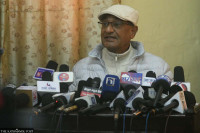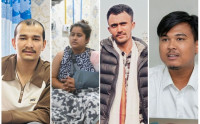National
When pilots stay home, their flying skills get rusty and it can be tough getting back in the air
There are also regulations that pilots need to abide by, including flight hours and three takeoffs and landings in the last 90 days, which is impossible during the lockdown.
Abhaya Raj Joshi
Nepal Airlines' Senior First Officer Suraj Bhandari is home with his newborn. With his long working hours and frequent overnight flights, Bhandari, whose spouse is also a pilot, never really got to spend time with his family.
"The lockdown has given me time to spend with my family," said 32-year-old Bhandari, who has been flying commercially for eight years now. "But after a few days of enjoying the long break, I’ve returned to my study table to sharpen my piloting skills."
A majority of the 550-odd Nepali pilots working for various airlines, and thousands of others worldwide, have been forced to stay home as the Covid-19 pandemic has shut down airports and cancelled flights. Governments across the world, including that of Nepal, have halted both domestic and international flights and there's uncertainty over when things will get back to normal for the aviation industry.
As uncertainty looms, pilots say they might face a host of challenges if restrictions remain in place for a long time. The nationwide lockdown, which has already been extended twice, is likely to have a massive impact on the Nepali aviation sector. According to an IATA estimate, more than 175,100 jobs in the sector are expected to be lost due to the pandemic, with a 39 percent drop in passenger demand compared to the previous year. The Airline Operators’ Association Nepal is already considering pay cuts for pilots.
But that's not the only worry for pilots, who require frequent training and flight hours to be able to fly commercially. According to CAAN regulations formulated under ICAO guidelines, a pilot can only fly if they have successfully carried out three takeoffs and landings within the previous 90 days on the same type of aircraft or in a flight simulator approved for the purpose. If the lockdown extends beyond 90 days, then a majority of pilots who are at home will not be allowed to fly, unless the rules are amended.
Pilots also need to undergo a licence proficiency check every year, and an operational proficiency check every six months to keep their licences valid. Nepali Airlines send their pilots to places such as Indonesia, the UK and Thailand for this check as there are no flight simulators in Nepal.
With lockdowns resulting from the pandmeic and restrictions affecting more than half of the world's population, demand for simulator slots is expected to increase exponentially and not all pilots may get to train on time.
Pilots need to fly as frequently as possible so that they remember procedures properly, said Bhandari. If a pilot doesn’t fly for a long time, getting familiar with the hundreds of buttons and switches can become challenging, he said. But with the lockdown, pilots don’t have that luxury.
Various aviation regulators around the world are considering measures to provide extensions to pilots to comply with mandatory checks. In Europe, for example, the EU Aviation Safety Agency has extended deadlines for certain requirements on the condition that airlines come up with detailed pilot training plans.
In Nepal, the Civil Aviation Authority is also keeping a close eye on the situation.
“As this is a global problem, we expect ICAO to come up with a circular soon," said Januka Khanal, director at the authority's licensing division. All pilots in Nepal are currently in compliance with the mandatory checks, she said.
For pilots who are at home, returning to their study tables is the only way to keep themselves focussed. Senior Captain Prabhakar Ghimire said that he is going through various flight manuals to keep himself updated while others are resorting to computer-based flight simulators during the lockdown.
But given the uncertainty over when the lockdown will end, neither Bhandari nor Ghimire knows when they will get back to flying.
In the meantime, Bhandari is trying a different method to keep himself on his toes.
"I use a technique called ‘chair flying’ which I learnt in flight school,” he said. “I sit on a chair and imagine that I am in a cockpit and try pushing imaginary buttons and switches. It's working for me.”




 7.12°C Kathmandu
7.12°C Kathmandu













%20(1).jpg&w=300&height=200)

